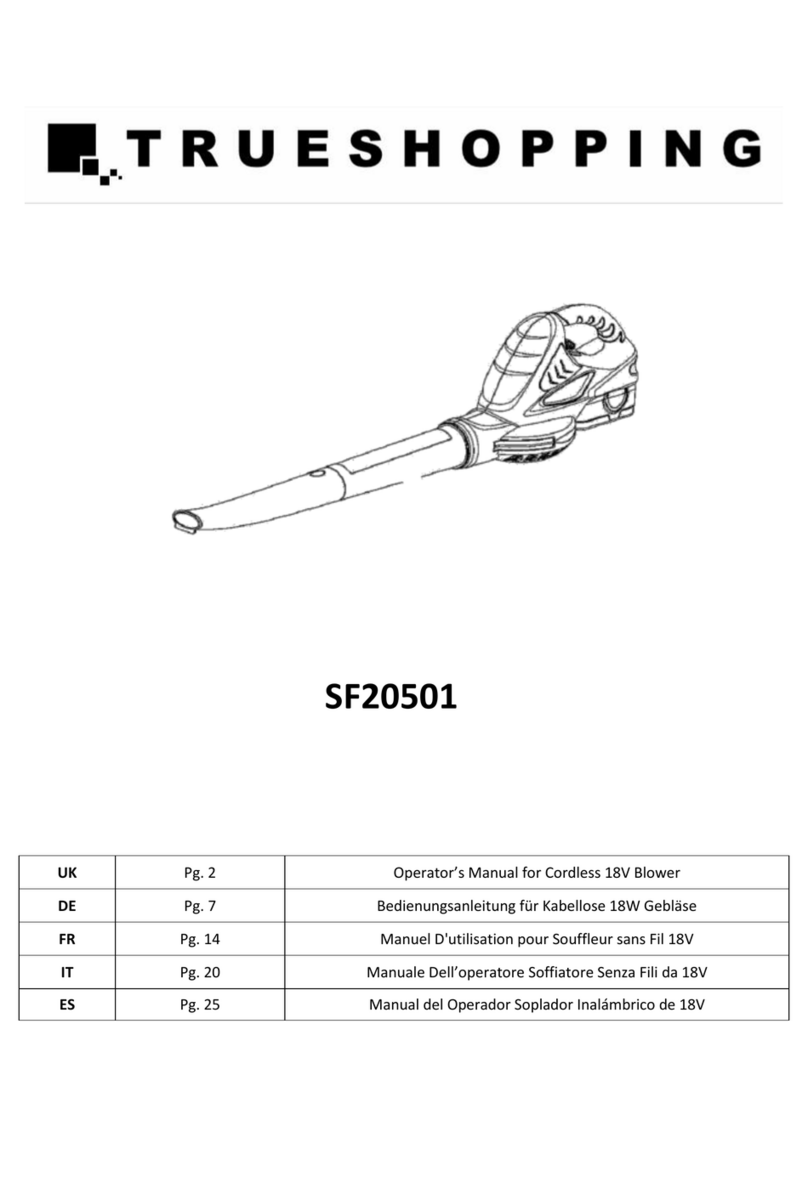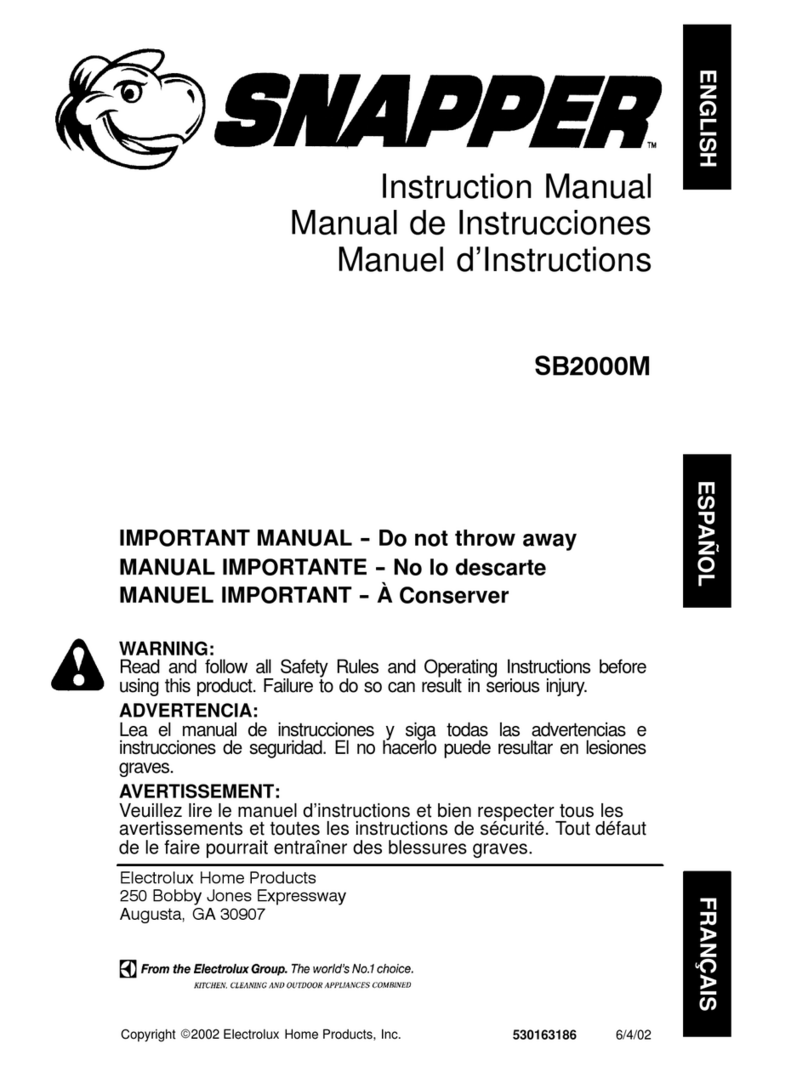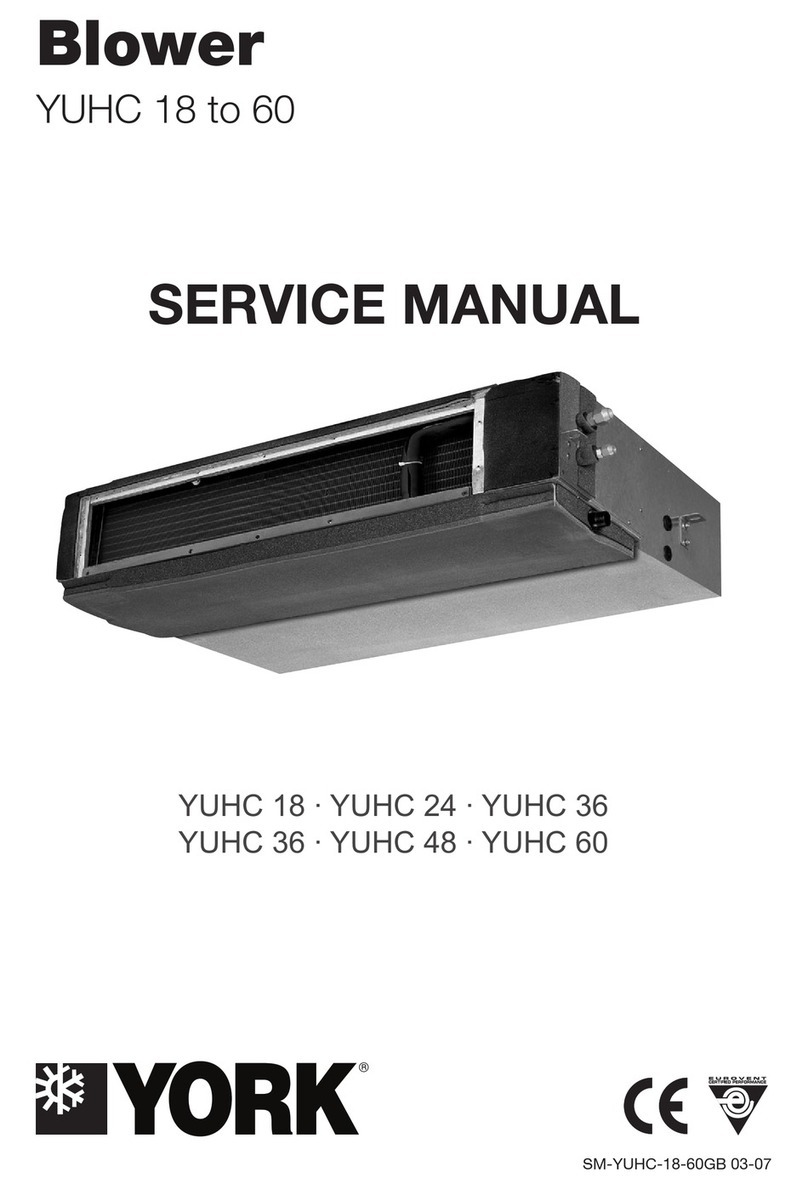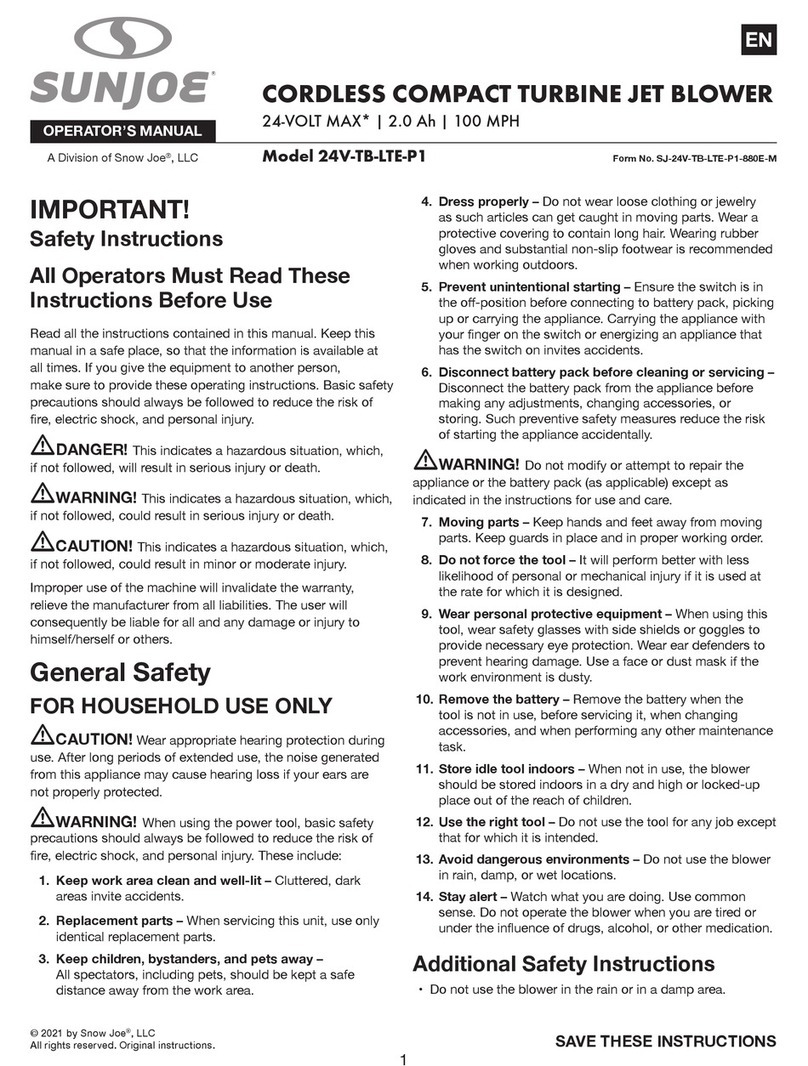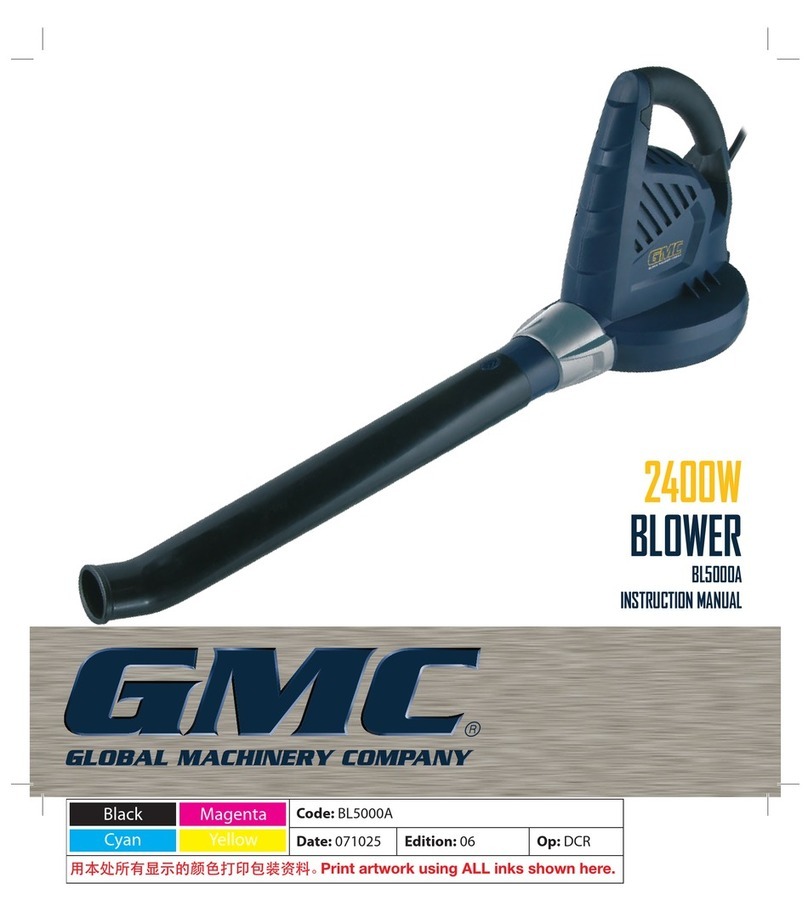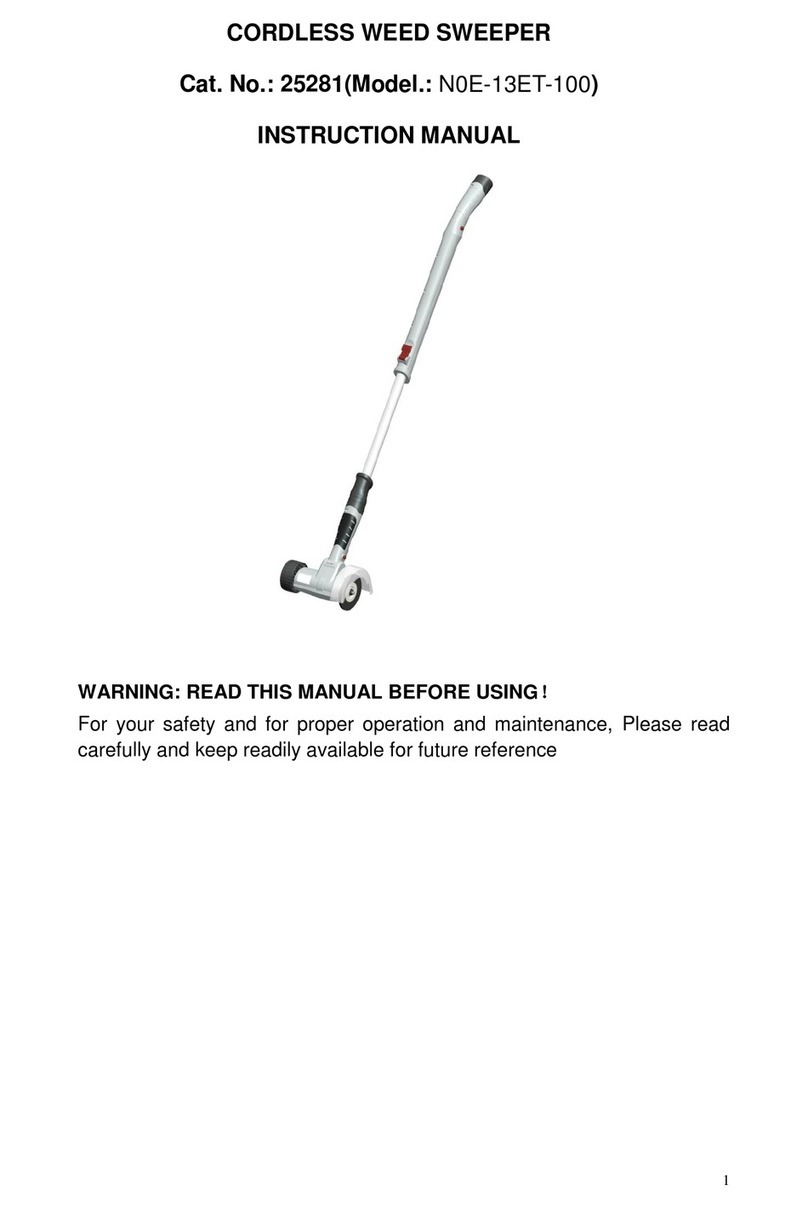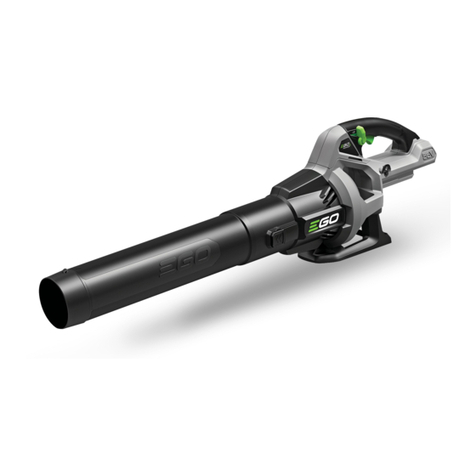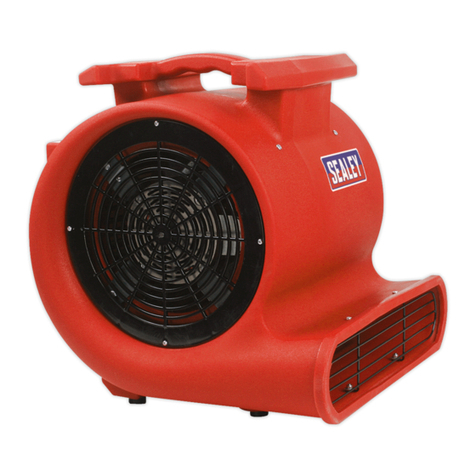Trueshopping SFBV00B5SA User manual

1
INSTRUCTION MANUAL
36V Lithium-Ion Cordless Blower
Model # SFBV00B5SA
Have product questions or need technical support? Please feel free to contact us!
Website: www.trueshopping.co.uk
Phone: 0333 320 7794

2
CONTENTS
Technical data…...………………………………………………………... 2
General safety rules…….………………………………………………... 3
Symbols………………………………………………………………….. 6
Knowing your blower……. ..…………………………………………… 8
Assembly instruction……………………………………………………… 9
Operating instruction…………………………………………………...... 10
Maintenance.……………………………………………………………… 11
Environmentally safe battery disposal……………………………………... 12
Troubleshooting…………………………………………………………. 12
Exploded view & parts list……………………………………………… 13
Warranty………………………………………………………………… 15
TECHNICAL DATA
36V Lithium-ion cordless blower Model # SFBV00B5SA
Power input: 36V
Blower speed: 174MPH
No-load speed: 14000 RPM
Battery type: 36V Lithium-ion
Charging time: 1.5 Hours
Charger rating: Input: 120VAC,60Hz, 1.3A; Output: 36V DC,2.1A
Package dimensions (L x W x H): 16.5 x7.5 x12 inches
Weight: 7 lb.
Warning! We strongly recommend that this item not be modified and/or used for any application
other than that for which it was designed. If you have any questions relative to its application, do not
use the equipment until you have consulted us and we have advised you.
Thank you for purchasing Trueshopping products.
Important: Our company does not provide email or personal information to any third party for any
reason. For any questions check our website or call customer service at 0333 320 7794.

3
GENERAL SAFETY RULES
Safety is a combination of common sense, staying alert, and knowing how your blower works.
SAVE THESE SAFETY INSTRUCTIONS.
WARNING: Do not operate this unit until you read this instruction manual for safety,
operation and maintenance instructions. Failure to follow all instructions listed below may
result in electric shock, fire, and/or serious personal injury.
➢Do not operate power tools in explosive atmospheres, such as in the presence of flammable liquids,
gases, or dust. Power tools create sparks which may ignite the dust or fumes.
➢Do not allow children or untrained individuals to use this unit.
➢Don’t expose power tools to rain or wet conditions. Water entering a power tool will increase the risk
of electric shock.
➢Do not handle plug or tool with wet hands.
➢Never allow children to operate the equipment. Never allow adults to operate the equipment without
proper instruction.
➢Always wear safety glasses with side shields that comply with ANSI Z87.1. Everyday glasses have
only impact resistant lenses. They are NOT safety glasses. Following this rule will reduce the risk of
eye injury. Use face mask if operation is dusty.
➢Wear eye protection when operating this product. Secure long hair above shoulder level to prevent
entanglement in moving parts.
➢Use extra care when cleaning on stairs.
➢Do not expose to rain, store indoors.
➢Do not operate in poor lighting.
➢Keep all parts of your body away from any moving part.
➢Keep hair, loose clothing, fingers and all body parts away from openings and moving parts.
➢Wear heavy long pants, boots, and gloves. Avoid loose garments and jewelry that could get caught in
moving parts of the machine or its motor.
➢Do not force tool. Use the correct tool for your application. The correct tool will do the job better and
safer at the rate for which it is designed.
➢Do not operate the equipment while barefoot or when wearing sandals or similar lightweight footwear.
Wear protective footwear that will protect your feet and improve your footing on slippery surfaces.
➢Secure long hair so it is above shoulder level to prevent entanglement in any moving parts.
➢Keep firm footing and balance. Do not overreach. Overreaching can result in loss of balance.
➢Do not allow to be used as a toy. Close attention is necessary when used by or near children.
➢Do not use tool if switch does not turn it on or off. Any tool that cannot be controlled with the switch is
dangerous and must be repaired.
➢Keep all bystanders, children, and pets at least 50 ft. away.
➢Do not operate this unit when you are tired, ill, or under the influence of alcohol, drugs, or medication.
➢Keep all parts of your body away from any moving parts and all hot surfaces of the unit.
➢Do not put any object into openings. Do not use with any opening blocked; keep openings free of dust,
lint, hair, and anything that may reduce air flow.

4
➢Check the work area before each use. Remove all objects such as rocks, broken glass, nails, wire, or
string which can be thrown or become entangled in the machine.
➢Use only identical manufacturer’s replacement parts and accessories. Use of any other parts may create
a hazard or cause product damage.
➢Do not charge battery tool in rain, or damp or wet location. Follow this rule will reduce the risk of
electric shock.
➢For household use only.
➢Battery tools do not have to be plugged into an electrical outlet; therefore, they are always in operating
condition. Be aware of possible hazards when not using your battery tool or when changing accessories.
Following this rule will reduce the risk of electric shock, fire, or serious personal injury.
➢Remove or disconnect battery before servicing, cleaning or removing material from the gardening
appliance.
➢Use only TRUESHOPPING battery
➢Store idle appliances - When not in use, blower should be stored indoors in a dry, locked place out of
the reach of children.
➢Do not dispose of the batteries in a fire. The cell may explode. Check with local codes for possible
special disposal instructions.
➢Do not open or mutilate the batteries. Released electrolyte is corrosive and may cause damage to the
eyes or skin. It may be toxic if swallowed.
➢Do not place battery tools or their batteries near fire or heat. This will reduce the risk of explosion and
possibly injury.
➢Batteries can explode in the presence of a source of ignition, such as a pilot light. To reduce the risk of
serious personal injury, never use any cordless product in the presence of open flame. An exploded
battery can propel debris and chemicals. If exposed, flush with water immediately.
➢Do not crush, drop or damage battery pack. Do not use a battery pack or charger that has been dropped
or received a sharp blow. A damaged battery is subject to explosion. Properly dispose of a dropped or
damaged battery immediately.
➢Exercise care in handling batteries in order not to short the battery with conducting materials such as
rings, bracelets, and keys. The battery or conductor may overheat and cause burns. Do not open or
mutilate the batteries. Released electrolyte is corrosive and may cause damage to the eyes or skin. It
may be toxic if swallowed.
➢For best results, your battery tool should be charged in a location where the temperature is more than
45°F but less than 104°F. To reduce the risk of serious personal injury, do not store outside or in
vehicles.
➢Under extreme usage or temperature conditions, battery leakage may occur. If liquid comes in contact
with your skin, wash immediately with soap and water, then neutralize with lemon juice or vinegar. If
liquid gets into your eyes, flush them with clean water for at least 10 minutes, then seek immediate
medical attention. Following this rule will reduce the risk of serious personal injury.
➢If the power supply cord is damaged, it must be replaced only by the manufacturer or by an authorized
service center to avoid risk.
➢Do not point the blower nozzle in the direction of people or pets.
➢Never run the unit without the proper equipment attached. Always ensure the sweeper tubes are
installed.
➢Maintain tool with care. Keep fan area clean for best and safest performance. Follow instructions for
proper maintenance. Do not attempt to clear clogs from tool without first removing the battery.

5
➢To reduce the risk of electrical shock, do not expose to rain, do not use on wet surfaces. Store indoors.
➢Save these instructions. Refer to them frequently and use them to instruct others who may use this
battery tool. If you loan someone this battery tool, loan them these instructions also.
CHILD SAFETY
Tragic accidents can occur if the operator is not aware of the presence of children.
➢Keep children out of the working area and under the watchful care of a responsible adult.
➢Do not allow children under the age of 14 to operate this blower. Children who are 14 years of age and
older must read and understand the operating instructions and safety rules in this manual and must be
trained and supervised by a parent.
➢Stay alert and turn the blower off if a child or any other person enters the mowing area.
➢Use extreme care when approaching blind corners, doorways, shrubs, trees, or other objects that may
obscure your view of a child who may run into the path of the blower.
WARNING:
Some dust created by power sanding, sawing, grinding, drilling and other construction activities
contains chemicals known to cause cancer, birth defects or other reproductive harm. Some
examples of these chemicals are:
•Lead from lead-based paints,
•Crystalline silica from bricks and cement and other masonry products, and
•Arsenic and chromium from chemically-treated lumber.
Your risk from these exposures varies, depending on how often you do this type of work. To reduce your
exposure to these chemical: work in a well-ventilated area, and work with approved safety equipment, such as
those dust masks that are specially designed to filter out microscopic particles.
SAVE THESE INSTRUCTIONS

6
SYMBOLS
Some of the following symbols may be used on this product. Please study them and learn their
meaning. Proper interpretation of these symbols will allow you to operate the product better and safer.
SYMBOL
NAME
DESIGNATION/EXPLANATION
V
Volts
Voltage
A
Amperes
Current
Hz
Hertz
Frequency (cycles per second)
W
Watts
Power
min
Minutes
Time
Safety Alert
Precautions that involve your safety.
Read the user’s
manual
To reduce the risk of injury, user must read and understand user’s manual
before using this product.
Eye protection
Wear eye protection that is marked to comply with ANSI Z87.1 when
operating this equipment.
Wet conditions
alert
Do not expose to rain or use in damp locations.
Long hair
Failure to keep long hair away from the air inlet could result in personal
injury.
Loose clothing
Failure to keep loose clothing from being drawn into air intake could
result in personal injury.
Keep Bystanders
away
Keep all bystanders at least 50 ft. away.
Blower tubes
Do not operate without tubes in place.
Electric shock
alert
Beware of electric shock hazard.

7
The following signal words and meanings are intended to explain the levels of risk associated with this
product.
SYMBOL SIGNAL MEANING
DANGER Indicates an imminently hazardous situation, which, if not avoided,
will result in death or serious injury.
WARNING Indicates a potentially hazardous situation, which, if not avoided,
could result in death or serious injury.
CAUTION Indicates a potentially hazardous situation, which, if not avoided,
may result in minor or moderate injury.
CAUTION (Without Safety Alert Symbol) Indicates a situation that may
result in property damage.
ENVIRONMENTAL PROTECTION
Waste electrical products should not be disposed of with household waste. Please
recycle where facilities exist. Check with your local authority or retailer for recycling
advice.
The battery contains material which is hazardous to you and the environment. It must
be removed and disposed of separately at a facility that accepts lithium-ion batteries.
SERVICE
Servicing requires extreme care and knowledge and should be performed only by a qualified service
technician. For service we suggest you return the product to your nearest AUTHORIZED SERVICE
CENTER for repair. When servicing, use only identical replacement parts.
WARNING: To avoid serious personal injury, do not attempt to use this product until you have
read this Owner's Manual thoroughly and understand it completely. If you do not understand the
warnings and instructions in this Owner's Manual, do not use this product. Call the Toll-free
Helpline (0333 320 7794) for assistance.
WARNING:
The operation of any power tool can result in foreign objects being thrown into your eyes, which
can result in severe eye damage. Before beginning power tool operation, always wear safety
goggles or safety glasses with side shields and, when needed, a full face shield. We recommend Wide
Vision Safety Mask for use over eyeglasses or standard safety glasses with side shields. Always use eye
protection which is marked to comply with ANSI Z87.1.

8
KNOWING YOUR BLOWER
Unpacking
Unpack the blower and all its parts, and compare against the list below. Do not discard the carton or any
packaging materials. Please call 0333 320 7794 if any parts are damaged or missing.
Including:
➢Blower
➢36V Battery and Charger
➢User manual
➢Blower tube
A
Blower small tube
B
Lock off button
C
E
On/Off trigger switch
Blower big tube
D
Battery door
D
A
B
C
E

9
ASSEMBLY INSTRUCTIONS
INSTALLING THE BLOWER TUBE
CAUTION: Always ensure that the tool is switched off and the battery is removed before making any
adjustments or maintenance procedures.
➢Slide the small tube (C) over the big tube (B) until the latch on the big tube is inserted into the end of
the opening on the small tube and locks into position (see fig.1)
➢Align the widest end of the big tube (B) with the front opening on the blower (A). (see fig 2)
CONNECTING AND REMOVING BATTERY
IMPORTANT!
The battery pack is not charged when it is purchased. Before using the blower for the first time, place the
battery pack in the battery charger and charge. Make sure to read all safety precautions, and follow the
instructions in the battery charger section.
To remove the battery pack
➢Press the button (1) of battery door, then open it (see fig.3)
➢Press the battery release button (2) at the back of the battery pack (see fig 4)
➢Slide the battery pack backward, and then pull or lift the battery out of the tool (see fig 5).
To install the battery pack
To install the battery pack into the tool, align the rails of the battery pack with the rails in the tool and push
the battery into the housing. To connect the battery, slide the battery pack fully forward. Until the latch
locks into place.
Fig. 1
Fig. 2
1
2
Fig. 2
Fig. 3
Fig. 4
Fig. 5
C
B
B
A
Fig. 1

10
WARNING:
Follow these instructions in order to avoid injury and to reduce the risk of electric shock or fire:
➢Replace the battery pack or the charger immediately if the battery case or charger cord is
damaged.
➢Verify that the battery pack is removed before inspecting, adjusting, or performing maintenance on any
part of the blower.
➢Read, understand, and follow the instructions.
OPERATING INSTRUCTIONS
WARNING: Read and thoroughly understand all instructions and safety information before
operating this blower. Failure to do so may cause serious injury or death. Do not allow anyone to
operate this blower who has not read this manual. a blower can be dangerous if assembled or
used improperly. Do not operate this blower if you have doubts or questions concerning safe operation. Call
our customer service department at 0333 320 7794 to address these concerns.
STARTING/STOPPING THE BLOWER
➢Install the battery pack. (Refer to Installing the battery pack)
➢To switch on squeeze the trigger switch (1)
➢To switch off, release the trigger switch (1).
Use the blower to (see fig.)
➢Blow debris or grass clippings off of driveways, sidewalks, patios, parks, parking lots, etc.
➢Gather grass clippings, straw, or leaves into piles.
➢Remove debris from corners, around joints, and between bricks.
1

11
MAINTENANCE
WARNING:
In order to avoid personal injury and the risk of fire and electric shock, remove the battery pack
before adjusting, inspecting, or cleaning the blower.
CLEANING
Remove the battery pack.
➢Brush or blow dust and debris out of the air vents using compressed air or a vacuum. Keep the air vents
free of obstructions, sawdust, and wood chips. Do not spray, wash, or immerse the air vents in water.
➢Wipe off the housing and the plastic components using a moist, soft cloth. Do not use strong solvents or
detergents on the plastic housing or plastic components. Certain household cleaners may cause damage,
and may cause a shock hazard.
BATTERY PACK
➢Store the battery pack fully charged.
➢Once the charging light turns green, remove the battery from the charger and disconnect the charger
from the outlet.
➢Do not store the battery pack on the tool.
➢After charging, the battery pack may be stored in the charger, as long as the charger is not plugged in.
CHARGER MAINTENANCE
➢Keep the charger clean and clear of debris. Do not allow foreign material to get into the recessed cavity
or onto the contacts. Wipe the charger clean with a dry cloth. Do not use solvents or water, and do not
place the charger in wet conditions.
➢Unplug the charger when there is no battery pack in it.
➢Fully charge the batteries before placing them in storage.
➢Store the charger at normal room temperature. Do not store it in excessive heat. Do not use the charger
in direct sunlight. Recharge at room temperature between 45˚F and 104˚F. If the battery pack is hot,
allow it to cool down before recharging.

12
ENVIRONMENTALLY SAFE BATTERY DISPOSAL
The batteries used in this blower's battery pack contain the following toxic and corrosive material:
LITHIUM-ION.
WARNING:
Toxic materials must be disposed of in a specified manner in order to prevent contamination of
the environment. Before disposing of damaged or worn out Lithium-Ion battery packs, contact
your local waste disposal agency for information and specific instructions. Take the batteries to a local
recycling and/or disposal centre that is certified for disposal.
If the battery pack cracks or breaks, whether it leaks or not, do not recharge it and do not use it. Dispose of
it and replace it with a new battery pack. DO NOT ATTEMPT TO REPAIR IT!
Follow these instructions in order to avoid injury and the risk of fire, explosion, or electric shock, and to
avoid damage to the environment:
➢Cover the battery's terminals with heavy-duty adhesive tape.
➢Do not attempt to remove or destroy any of the components of the battery pack.
➢Do not attempt to open the battery pack.
➢If a leak develops, the electrolytes that are released are corrosive and toxic. Do not get the solution in
the eyes or on the skin, and do not swallow it.
➢Do not place batteries in regular household trash.
➢DO NOT incinerate batteries.
➢DO NOT place batteries where they will become part of any waste landfill or municipal solid
waste stream.
➢Dispose of batteries at a certified recycling or disposal centre.
TROUBLE SHOOTING
The following form lists the common operating system with problem and solutions. Please read the form
carefully and follow it.
PROBLEMS
POSSIBLE CAUSES
SOLUTION
Motor fails to start when
Switch trigger is
depressed.
Battery is not secure.
Battery is not charged.
To secure the battery pack, make sure
the latches on the top of the battery pack
snap into place.
Charge the battery pack according to the
Instruction included with your model.
Unit will not start
Defective power switch.
Return to place of purchase or return the
unit to a repair center.
Unit will not blow
Blocked tube
Clear the blockage.

13
EXPLODED VIEW & PARTS LIST

14
Item
Stock#
Description
QTY
1
PS76201A-001
Right housing
1
2
PS76201A-002
switch-trigger
1
3
PS76201A-003
Pushing button
1
4
PS76201A-004
Brake spring
1
5
PS76201A-005
Leverage torsional spring
1
6
PS76201A-006
Leverage
1
7
PS76201A-007
Compressive bar
1
8
PS76201A-008
Micro switch
1
9
PS76201A-009
Connecting rod
1
10
PS76201A-010
Governor
1
11
PS76201A-011
Cushioning
2
12
PS76201A-012
Motor
1
13
PS76201A-013
Motor fixed plate
1
14
PS76201A-014
Screw
2
15
PS76201A-015
Fan
1
16
PS76201A-016
Screw
2
17
PS76201A-017
Lock the fixed plate
1
18
PS76201A-018
Brake spring
1
19
PS76201A-019
locking
1
20
PS76201A-020
Battery button
1
21
PS76201A-021
Left housing
1
22
PS76201A-022
Pin
1
23
PS76201A-023
Fixed block
1
24
PS76201A-024
Battery pack
1
25
PS76201A-025
Shield
1
26
PS76201A-026
Press button spring
1
27
PS76201A-027
Switch for cover
1
28
PS76201A-028
Screw
15
29
PS76201A-029
Battery housing
1
30
PS76201A-030
Fixed block
1
31
PS76201A-031
Contact clip
2
32
PS76201A-032
Spring
1
33
PS76201A-033
Pin
1
34
PS76201A-034
Switch for duct
1
35
PS76201A-035
Big duct
1
36
PS76201A-036
Charger
1
37
PS76201A-037
Small duct
1

15
TWO (2) YEARS LIMITED WARRANTY
Trueshopping is committed to building tools that are dependable for years. Our warranties are consistent with our
commitment and dedication to quality.
TWO (2) YEARS LIMITED WARRANTY OF TRUESHOPPING PRODUCTS FOR HOME USE.
Trueshopping (“Seller") warrants to the original purchaser only, that all Trueshopping consumer power tools will be
free from defects in material or workmanship for a period of two (2) years from date of purchase. Ninety (90) days for
all Trueshopping products, if the tool is used for professional or commercial use.
SELLER’S SOLE OBLIGATION AND YOUR EXCLUSIVE REMEDY under this Two (2) Years Limited
Warranty and, to the extent permitted by law, any warranty or condition implied by law, shall be the repair or
replacement of parts, without charge, which are defective in material or workmanship and which have not been
misused, carelessly handled, or misrepaired by persons other than Seller or Authorized Service Center. To make a
claim under this Limited Warranty, you must return the entire power tool product; transportation prepaid, to
Trueshopping include a legible copy of the original receipt, which lists the date of purchase (month and year) and the
name of the company purchased from.
THIS LIMITED WARRANTY DOES NOT APPLY TO ANY ACCESSORY ITEMS INCLUDED WITH THE
TOOL SUCH AS CIRCULAR SAW BLADES OTHER RELATED ITEMS OR TO ANY REPLACEMENT
PARTS LISTED UNDER MAINTENANCE.
ANY IMPLIED WARRANTIES SHALL BE LIMITED IN DURATION TO TWO (2) YEARS FROM DATE OF
PURCHASE. SOME STATES IN THE U.S. AND SOME CANADIAN PROVINCES DO NOT ALLOW
LIMITATIONS ON HOW LONG AN IMPLIED WARRANTY LASTS, SO THE ABOVE LIMITATION MAY
NOT APPLY TO YOU.
IN NO EVENT SHALL SELLER BE LIABLE FOR ANY INCIDENTAL OR CONSEQUENTIAL DAMAGES
(INCLUDING BUT NOT LIMITED TO LIABILITY FOR LOSS OF PROFITS) ARISING FROM THE SALE OR
USE OF THIS PRODUCT. SOME STATES IN THE U.S. AND SOME CANADIAN PROVINCES DO NOT
ALLOW THE EXCLUSION OR LIMITATION OF INCIDENTAL OR CONSEQUENTIAL DAMAGES, SO THE
ABOVE LIMITATION OR EXCLUSION MAY NOT APPLY TO YOU.
THIS LIMITED WARRANTY GIVES YOU SPECIFIC LEGAL RIGHTS, AND YOU MAY ALSO HAVE
OTHER RIGHTS WHICH VARY FROM STATE TO STATE IN THE U.S., PROVINCE TO PROVINCE IN
CANADA AND FROM COUNTRY TO COUNTRY.
For questions / comments, technical assistance or repair parts please call: 0333 320 7794 (M-F 8.30am - 5pm)
SAVE YOUR RECEIPTS. THIS WARRANTY IS VOID WITHOUT THEM.

16
BEDIENUNGSANLEITUNG
36V Laubbläser mit Lithiumbatterie 36V / Li –Ion
Modell # SFBV00B5SA

17
TECHNISCHE DATEN / CARACTÉRISTIQUES

ALLGEMEINE SICHERHEITSHINWEISE
FÜR ELEKTROWERKZEUGE
WARNUNG! Lesen Sie alle Hinweise aufmerksam
durch. Eine Missachtung
der nachstehenden Hinweise kann einen Stromschlag,
Feuer und/oder Verletzungen nach sich ziehen.
Bewahren Sie alle Sicherheitshinweise und
Anweisungen für die Zukunft auf.
Der in den Sicherheitshinweisen verwendete Begriff
„Elektrowerkzeug“ bezieht sich auf akkubetriebene
Elektrowerkzeuge (ohne Netzkabel).
1. ARBEITSPLATZSICHERHEIT
a) Halten Sie Ihren Arbeitsbereich sauber und gut
beleuchtet. Unordnung oder unbeleuchtete
Arbeitsbereiche können zu Unfällen führen.
b) Arbeiten Sie mit dem Elektrowerkzeug
nicht in explosionsgefährdeter Umgebung, in
der sich brennbare Flüssigkeiten, Gase oder
Stäube befinden. Elektrowerkzeuge erzeugen
Funken, die den Staub oder die Dämpfe entzünden
können.
c) Halten Sie Kinder und andere
Personen während der Benutzung des
Elektrowerkzeugs fern. Bei Ablenkung können Sie
die Kontrolle über das Gerät verlieren.
2. ELEKTRISCHE SICHERHEIT
a) Der Anschlussstecker des
Elektrowerkzeuges muss in die Steckdose passen.
Der Stecker darf in keiner Weise verändert werden.
Verwenden Sie keine Adapterstecker gemeinsam
mit schutzgeerdeten Elektrowerkzeugen.
Unveränderte Stecker und passende Steckdosen
verringern das Risiko eines elektrischen Schlages.
b) Vermeiden Sie Körperkontakt mit geerdeten
Oberflächen wie von Rohren, Heizungen, Herden
und
Kühlschränken. Es besteht ein erhöhtes Risiko durch
elektrischen Schlag, wenn Ihr Körper geerdet ist.
c) Halten Sie Elektrowerkzeuge von Regen oder
Nässe fern. Das Eindringen von Wasser in ein
Elektrowerkzeug erhöht das Risiko eines elektrischen
Schlages.
d) Zweckentfremden Sie das Kabel nicht, um das
Elektrowerkzeug zu tragen, aufzuhängen oder um
den Stecker aus der Steckdose zu ziehen. Halten
Sie das Kabel fern von Hitze, Öl, scharfen Kanten
oder sich bewegenden Geräteteilen. Beschädigte
oder verwickelte Kabel erhöhen das Risiko eines
elektrischen Schlages.
e) Wenn Sie mit einem Elektrowerkzeug im Freien
arbeiten, verwenden Sie nur Verlängerungskabel,
die auch für den Außenbereich geeignet sind. Die
Anwendung eines für den Außenbereich geeigneten
Verlängerungskabels verringert das Risiko eines
elektrischen Schlages.
f) Wenn der Betrieb des
Elektrowerkzeuges in feuchter Umgebung
nicht vermeidbar ist, verwenden Sie einen
Fehlerstromschutzschalter. Der
Einsatz eines Fehlerstromschutzschalters vermindert
das Risiko eines elektrischen Schlages.
3. SICHERHEIT VON PERSONEN
a) Seien Sie aufmerksam, achten Sie darauf, was Sie
tun, und gehen Sie mit Vernunft an die Arbeit mit
einem Elektrowerkzeug. Benutzen Sie kein
Elektrowerkzeug, wenn Sie müde sind oder unter
dem Einfluss von Drogen, Alkohol oder
Medikamenten stehen.
Ein Moment der Unachtsamkeit beim Gebrauch des
Elektrowerkzeuges kann zu ernsthaften Verletzungen
führen.
b) Tragen Sie persönliche
Schutzausrüstung und immer eine Schutzbrille.
Das Tragen persönlicher Schutzausrüstung, wie
Staubmaske, rutschfeste Sicherheitsschuhe,
Schutzhelm oder Gehörschutz, je nach Art und Einsatz
des Elektrowerkzeuges, verringert das Risiko von
Verletzungen.
c) Vermeiden Sie eine unbeabsichtigte
Inbetriebnahme. Vergewissern Sie
sich, dass das Elektrowerkzeug ausgeschaltet ist,
bevor Sie es an den Akku anschließen, es
aufnehmen oder tragen. Wenn Sie beim Tragen des
Elektrowerkzeuges den Finger am Schalter haben
oder das Gerät eingeschaltet an die Stromversorgung
anschließen, kann dies zu Unfällen führen.
d) Entfernen Sie Einstellwerkzeuge oder
Schraubenschlüssel, bevor Sie das
Elektrowerkzeug einschalten. Ein
Werkzeug oder Schlüssel, der sich in einem drehenden
Geräteteil befindet, kann zu Verletzungen führen.
e) Vermeiden Sie eine abnormale Körperhaltung.
Sorgen Sie für einen sicheren Stand und halten Sie
jederzeit das Gleichgewicht.
Dadurch können Sie das Elektrowerkzeug in
unerwarteten Situationen besser kontrollieren.
f) Tragen Sie geeignete Kleidung.
Tragen Sie keine weite Kleidung oder Schmuck.
Halten Sie Haare, Kleidung und Handschuhe fern
von sich bewegenden Teilen. Lockere Kleidung,
Schmuck oder lange Haare können von sich
bewegenden Teilen erfasst werden.
g) Wenn Staubabsaug- und -auffangeinrichtungen
montiert werden können, vergewissern Sie sich,
dass diese angeschlossen sind und richtig
verwendet werden.
Verwendung einer Staubabsaugung kann
Gefährdungen durch Staub verringern.
4. VERWENDUNG UND BEHANDLUNG
DES ELEKTROWERKZEUGES
a) Überlasten Sie das Gerät nicht. Verwenden Sie für
Ihre Arbeit das dafür bestimmte Elektrowerkzeug.
Mit dem passenden Elektrowerkzeug arbeiten Sie
besser und sicherer im angegebenen
Leistungsbereich.
b) Benutzen Sie kein Elektrowerkzeug, dessen
Schalter defekt ist. Ein Elektrowerkzeug, das sich
nicht mehr ein- oder ausschalten lässt, ist gefährlich
und muss repariert werden.

c) Entfernen Sie den Akku, bevor Sie
Geräteeinstellungen vornehmen, Zubehörteile
wechseln oder das Gerät weglegen. Diese
Vorsichtsmaßnahme verhindert den unbeabsichtigten
Start des Elektrowerkzeuges.
d) Bewahren Sie unbenutzte
Elektrowerkzeuge außerhalb der
Reichweite von Kindern auf. Lassen Sie Personen
das Gerät nicht benutzen, die mit diesem nicht
vertraut sind oder diese Anweisungen nicht
gelesen haben. Elektrowerkzeuge sind gefährlich,
wenn Sie von unerfahrenen Personen benutzt werden.
e) Pflegen Sie Elektrowerkzeuge mit Sorgfalt.
Kontrollieren Sie, ob bewegliche Teile einwandfrei
funktionieren und nicht klemmen, ob Teile
gebrochen oder so beschädigt sind, dass die
Funktion des Elektrowerkzeuges beeinträchtigt ist.
Lassen Sie beschädigte Teile vor dem
Einsatz des Gerätes reparieren. Viele Unfälle
haben ihre Ursache in schlecht gewarteten
Elektrowerkzeugen.
f) Halten Sie Schneidwerkzeuge
scharf und sauber. Sorgfältig gepflegte
Schneidwerkzeuge mit scharfen Schneidkanten
verklemmen sich weniger und sind leichter zu führen.
g) Verwenden Sie Elektrowerkzeug, Zubehör,
Einsatzwerkzeuge usw. entsprechend diesen
Anweisungen. Berücksichtigen Sie dabei die
Arbeitsbedingungen und die auszuführende
Tätigkeit. Der Gebrauch von Elektrowerkzeugen für
andere als die vorgesehenen Anwendungen kann zu
gefährlichen Situationen führen.
5. VERWENDUNG UND BEHANDLUNG
DES AKKUWERKZEUGS
a) Laden Sie die Akkus nur in Ladegeräten auf, die
vom Hersteller empfohlen werden. Für ein
Ladegerät, das für eine bestimmte Art von Akkus
geeignet ist, besteht Brandgefahr, wenn es mit anderen
Akkus verwendet wird.
b) Verwenden Sie nur die dafür vorgesehenen Akkus
in den Elektrowerkzeugen. Der Gebrauch von
anderen Akkus kann zu Verletzungen und Brandgefahr
führen.
c) Halten Sie den nicht benutzten Akku fern von
Büroklammern, Münzen, Schlüsseln, Nägeln,
Schrauben oder anderen kleinen
Metallgegenständen, die eine Überbrückung der
Kontakte verursachen könnten. Ein Kurzschluss
zwischen den Akkukontakten kann Verbrennungen
oder Feuer zur Folge haben.
d) Bei falscher Anwendung kann Flüssigkeit aus dem
Akku austreten. Vermeiden Sie den Kontakt damit.
Bei zufälligem Kontakt mit Wasser abspülen. Wenn
die Flüssigkeit in die Augen kommt, nehmen Sie
zusätzlich ärztliche Hilfe in Anspruch. Austretende
Akkuflüssigkeit kann zu Hautreizungen oder
Verbrennungen führen.
6. SERVICE
a) Lassen Sie Ihr Elektrowerkzeug nur von
qualifiziertem Fachpersonal und nur mit
Original-Ersatzteilen reparieren. Damit wird
sichergestellt, dass die Sicherheit des Gerätes erhalten
bleibt.
ZUSÄTZLICHE SICHERHEITSPUNKTE
FÜR IHR WERKZEUG
WARNUNG! Beim Arbeiten mit dem Gerät
sind folgende
Sicherheitsvorschriften zu beachten.
Zu Ihrer eigenen und zur Sicherheit anderer lesen Sie diese
Sicherheitshinweise bitte aufmerksam durch, ehe Sie das
Gerät benutzen. Bewahren Sie diese Anleitung gut auf,
damit Sie sie bei Bedarf schnell zur Hand haben.
Bewahren Sie alle Sicherheitshinweise und
Anweisungen für die Zukunft auf.
-Dieses Gerät ist nicht dafür bestimmt, durch Personen
(einschließlich Kinder) mit eingeschränkten physischen,
sensorischen oder geistigen Fähigkeiten oder mangels
Erfahrung und/oder mangels Wissen
benutzt zu werden, es sei denn, sie werden durch eine für
ihre Sicherheit zuständige Person beaufsichtigt oder
erhielten von ihr Anweisungen, wie das Gerät zu
benutzen ist.
-Kinder sollten beaufsichtigt werden um Sicherzustellen, dass
sie nicht mit dem Ladegerät spielen.
1) TRAINING
a) Die Anweisungen aufmerksam durchlesen. Machen Sie
sich mit den Bedienelementen und dem
vorschriftsmäßigen Gebrauch des Rasenmähers
vertraut.
b) Nationale Vorschriften können das Alter der
Bedienperson möglicherweise beschränken.
c) Niemals mähen, während sich Personen, insbesondere
Kinder, oder Tiere in unmittelbarer Nähe aufhalten.
d) Die Bedienperson bzw. der Benutzer ist
für Unfälle oder Schäden an anderen Menschen oder
deren Eigentum verantwortlich.
2) VORBEREITUNG
a) Tragen Sie beim Mähen stets festes Schuhwerk und
eine lange Hose.
b) Tragen Sie keine lose Kleidung oder Schmuck, der in
den Lufteinlass gezogen werden kann. Halten Sie
langes Haar von den Lufteinlässen fern.
c) Tragen Sie bei der Arbeit Schutzhandschuhe.
d) Da bei der Arbeit viel Staub anfallen kann, sollten Sie
grundsätzlich eine Staubschutzmaske tragen.
e) Arbeiten Sie niemals mit dem Gerät, wenn
Schutzeinrichtungen oder Abschirmungen beschädigt
sind. Benutzen Sie das Gerät niemals ohne
angebrachte Sicherheitseinrichtungen, z. B.
Auffangbeutel.
3) BETRIEB
a) Ziehen Sie den Stecker aus der Steckdose, - Immer
wenn Sie die Maschine verlassen;
-Ehe Sie eine Blockierung beseitigen;
-Vor Wartungs-, Reinigungs- oder sonstigen Arbeiten an
der Maschine;
-Falls der Rasenmäher plötzlich ungewöhnlich stark zu
vibrieren beginnt (sofort prüfen).

b) Nur bei Tageslicht oder gutem künstlichen Licht mähen.
c) Beugen Sie sich nicht zu weit nach vorne, achten Sie
immer auf ihr Gleichgewicht.
d) Auf schrägen Flächen stets auf sicheren Tritt achten.
e) Gehen Sie; rennen Sie niemals mit dem Gerät.
f) Halten Sie sämtliche Lufteinlässe frei.
g) Blasen Sie niemals Gegenstände in Richtung
Zuschauer.
4) WARTUNG UND AUFBEWAHRUNG
a) Den Festsitz aller Schrauben, Muttern und Bolzen
sicherstellen, um zu gewährleisten, dass sich der
Rasenmäher in einem betriebssicheren Zustand
befindet.
b) Abgenutzte oder beschädigte Teile
sicherheitshalber auswechseln.
c) Verwenden Sie ausschließlich OriginalErsatzteile und
Originalzubehör.
d) Lagern Sie das Gerät grundsätzlich an
einem trockenen Ort.
SICHERHEIT HINWEISE FÜR
AKKUPACK
a) Zellen bzw. Akkupack nicht zerlegen, öffnen oder
zerdrücken.
b) Akkupack nicht kurzschließen. Akkupacks nicht
wahllos in einer Schachtel oder Schublade
aufbewahren, wo sie einander kurzschließen oder
durch andere leitfähige Materialien
kurzgeschlossen werden könnten. Bei
Nichtverwendung des Akkupacks ist dieses von
Metallgegenständen fernzuhalten, wie etwa
Büroklammern, Münzen, Nägeln, Schrauben oder
anderen kleinen Metallgegenständen, wo sich die
Batterieklemmen berühren könnten. Das Kurzschließen
der Batterieklemmen kann Verbrennungen bzw. einen
Brand verursachen.
c) Zellen bzw. Akkupacks nicht Hitze
oder Feuer aussetzen. Lagerung in direktem
Sonnenlicht vermeiden.
d) Akkupack nicht mechanischen Stößen aussetzen.
e) Im Fall, dass Flüssigkeit aus dem Akku austritt, darf
diese nicht in Kontakt mit der Haut oder den Augen
kommen. Sollte dies dennoch geschehen, den
betroffenen Bereich sofort mit viel Wasser spülen
und einen Arzt aufsuchen.
f) Beim Verschlucken einer Zelle oder eines
Akkupacks muss sofort ein Arzt herangezogen
werden.
g) Akkupack sauber und trocken halten.
h) Sollten die Klemmen des Akkupacks schmutzig
werden, diese mit einem sauberen, trockenen Tuch
abwischen.
i) Akkupackmuss vor Gebrauch aufgeladen werden.
Immer dieses Anweisungen beachten und den
korrekten Ladevorgang ausführen.
j) Akkupack bei Nichtverwendung nicht längere Zeit
aufladen lassen.
k) Nach längerer Lagerung des Gerätes ist es
eventuell notwendig, die Zellen oder das Akkupack
mehrere Male aufzuladen und zu entladen, um eine
optimale Leistung zu erhalten.
l) Akkupacks funktionieren bei normaler
Zimmertemperatur (20°C ± 5°C) am besten.
m) Beim Entsorgen von Akkupacks sollten Akkupacks
mit verschiedenen elektrochemischen Systemen
voneinander getrennt gehalten werden.
n) Nur mit dem von TANNER bezeichneten
Ladegerät aufladen. Kein Ladegerät verwenden,
das nicht ausdrücklich für den Gebrauch mit dem
Gerät vorgesehen ist. Ein Ladegerät, das für eine
bestimmte Art von Akkupackgeeignet ist, kann bei
Verwendung mit einem anderen Akkupack eine
Brandgefahr darstellen.
o) Kein Akkupack verwenden, das nicht für den
Gebrauch mit dem Gerät vorgesehen ist.
p) Akkupacks von Kindern fernhalten.
q) Die originalen Produktunterlagen zum späteren
Nachschlagen aufbewahren
r) Den Akku bei Nichtverwendung aus dem Gerät
nehmen.
s) Ordnungsgemäß entsorgen.
Table of contents
Languages:
Other Trueshopping Blower manuals
Popular Blower manuals by other brands
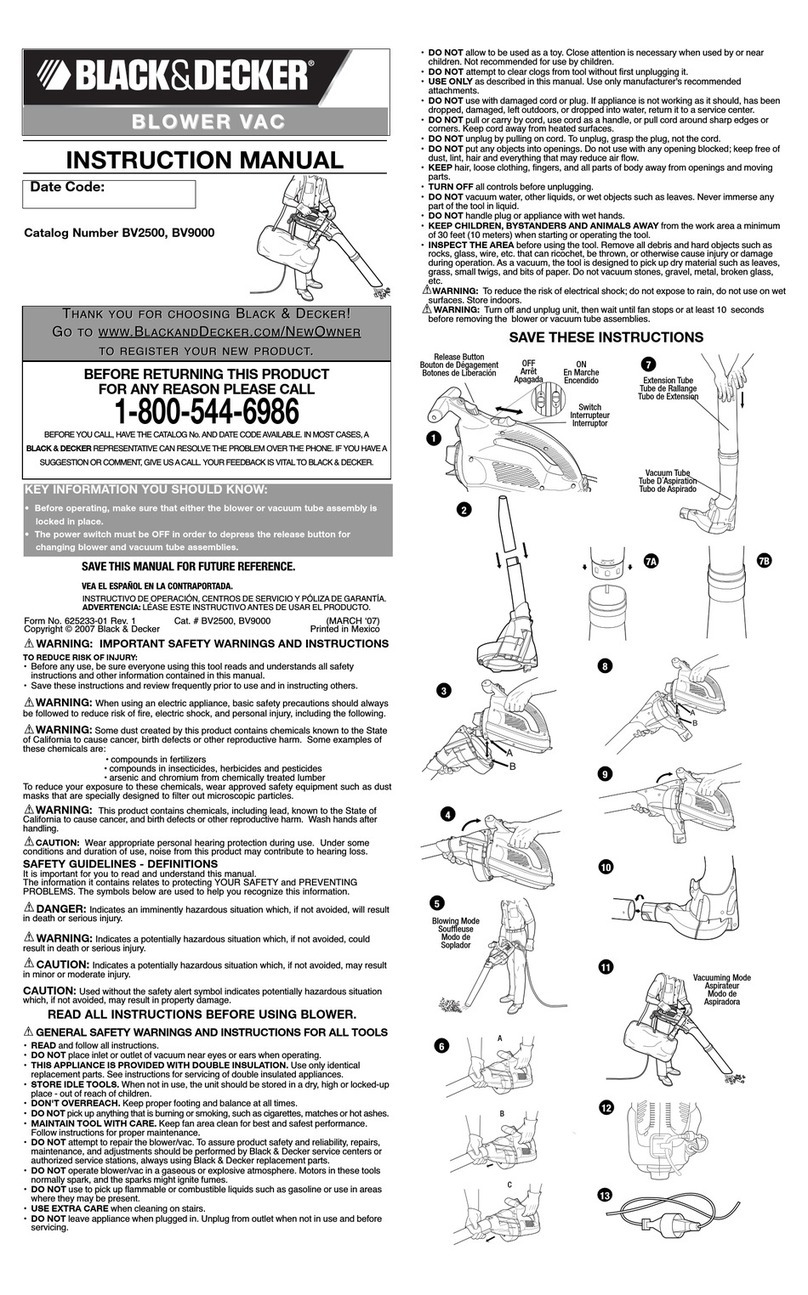
Black & Decker
Black & Decker 625233-01 instruction manual
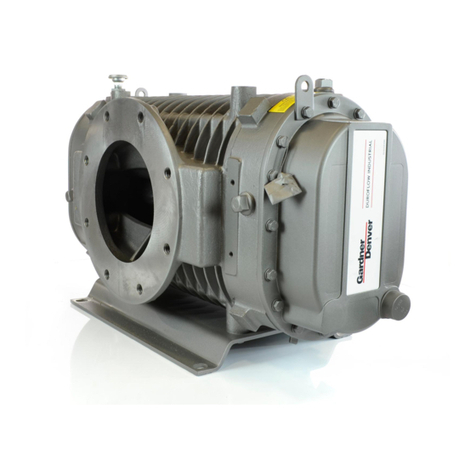
Gardner Denver
Gardner Denver DuroFlow 45 Series PARTS LIST OPERATING AND SERVICE MANUAL

Kobalt
Kobalt KHB 300-06 User instructions
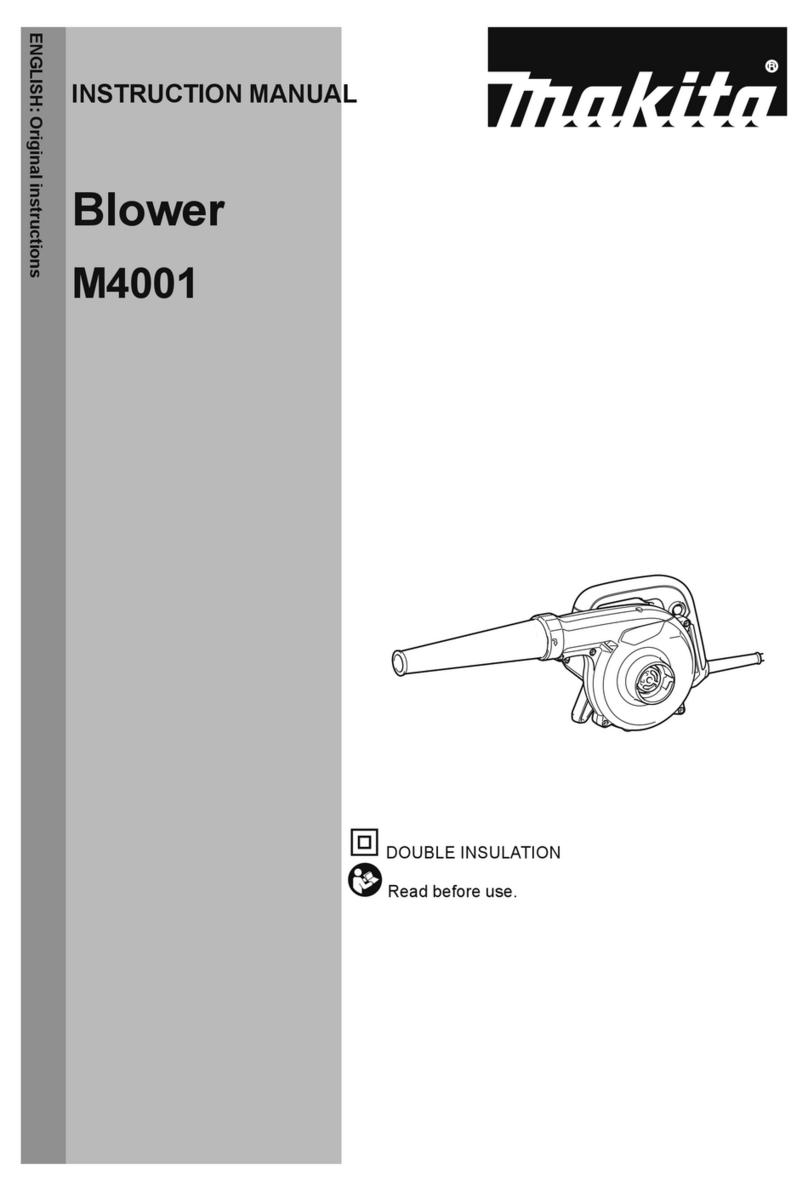
Makita
Makita M4001 instruction manual

Craftsman
Craftsman 358.794765 Operator's manual

McCulloch
McCulloch GB 320 Operator's manual

